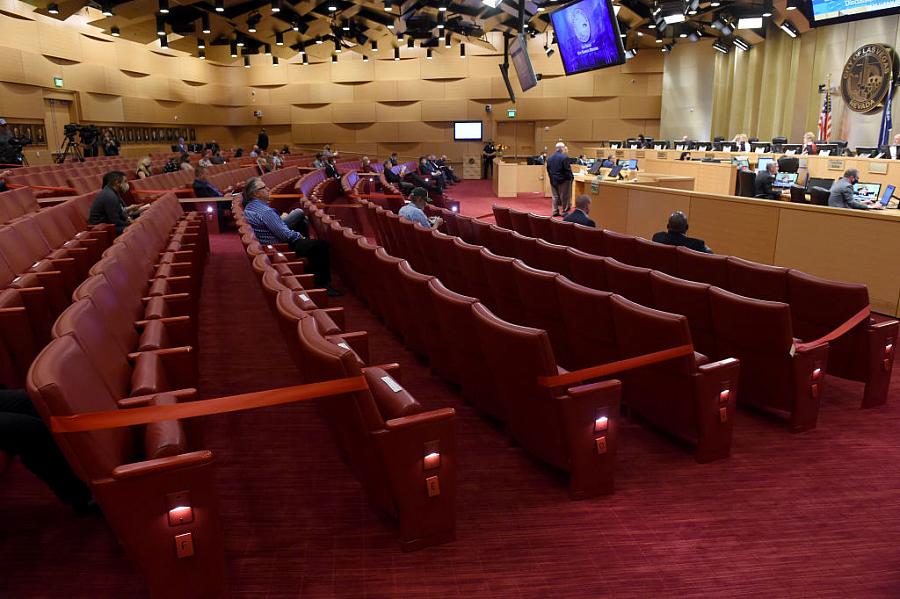COVID-19 is a big local story: Start documenting your community’s response

A city council meeting in Las Vegas, where every other row of seats was blocked off for social distancing.
(Photo by Ethan Miller/Getty Images)
The city of Atlanta is in the news for taking a stand in favor of mask wearing to prevent transmission of the COVID-19 virus.
But if you drive just 30 miles north to Alpharetta you can find another thread for journalists to follow about how state and local governments have handled the pandemic. Just as pulling apart the threads that led to the Sept. 11 terrorist attacks was so important to our collective understanding of that event, journalists have a critical role to play in helping their communities understand the origins and drivers of this pandemic.
The Sept. 11 attacks were concentrated in a few locations, including the locations where the terrorists trained. In this case, there are thousands of cities, counties, and states in the U.S. that are directly experiencing this disaster. As a journalist, you can capture in real time what they are doing — or not — to prevent the virus from devastating public health and the local economy, because let’s be clear to all the science-ignoring nihilists pitting the economy against public health: unhealthy and dead people are not good for business, nor is widespread fear of leaving the house.
Which brings me back to the city of Alpharetta, Georgia, just north of Atlanta.
The first deaths from COVID-19 were reported in King County, Washington, on Feb. 29, 2020. (Can’t wait for the conspiracy theorists to make hay out of that leap year twist.) Twelve days later, on March 12, the first death from COVID-19 was reported in Georgia. It’s hard to recall now, given that nearly 150,000 people are now dead in the United States from this disease, but back in early March, the death numbers were low and case counts were difficult to come by because of the lack of clear understanding of the disease and the shortage of test kits.
Even without a large case count from the disease, Alpharetta took action. On March 16, the Alpharetta City Council voted to enact a “state of emergency.” The order allowed the City Council to conduct the city’s governance virtually and to keep essential services running during the pandemic, both critical steps to maintain order amid the chaos that would come.
A few days later, on March 20, the city took a further step. It issued an interim order closing down all bars, restaurants, and other businesses, including gyms and theaters, that had space for 10 or more people. They also encouraged people to stay six feet away from each other when out in public. Note that there were still very few deaths from COVID-19 in Georgia — about 13.
On March 23, the City Council voted to fully approve the interim order.
That same day, Gov. Jay Inslee in the state of Washington issued a two-week quarantine requiring everyone in the state to stay at home. At that point, there had been 156 deaths from COVID-19 in Washington state. It’s easy to look back now and see the trajectory that we were on, but even recognizing that hindsight is 20/20, the potential for exponential growth in illness and death from COVID-19 was clear in early March. In these two examples you had a city in a state with very few deaths taking action, and a state with more deaths taking even bolder action. Meanwhile, you had cities and states in between the two coasts doing relatively little to nothing at all.
The task for journalists is to find out two things: 1. Who did what? 2. And was it enough?
One of the most important elements of this task is simply documenting what was done. This is actually harder than you might think and critically important in the era of accusations of “fake news.”
State and local governments have been moving at a rapid clip (or not moving in some cases), and you will want to look at your communities of interest and create a document that allows you to track what they did and when. Look for city council orders like the ones I mention above, as well as county and state orders. Start creating timelines for your region of interest.
There is no one-stop-shop for state and local actions. Efforts to compile some of these mandates have been done by government relations firms, including Multistate and Stateside. Note that every such repository I have reviewed to date is either incomplete, out of date, or both. So don’t take these lists as gospel. Do your own reporting, too.
You should consider actions by major employers, too. (A clear factor in Washington state’s ability to get ahead of the pandemic early was the decision by Microsoft, Amazon, and other huge employers to send their employees home to work instead of risking transmission at the office.)
Once you’ve assembled a narrative of official actions, you can then look at what has happened in your community during that same period. Have local hospitals been able to handle the patient loads? Have death counts crested and come down or are they climbing again? Are there other effects from these decisions or non-decisions that you can start to document and track? What other variables complicate the cause-and-effect patterns you’re seeking?
This isn’t a story that you will wrap up in a week. This is a series of stories that you will want to break as you develop evidence. It’s a story that won’t end until the pandemic does.

